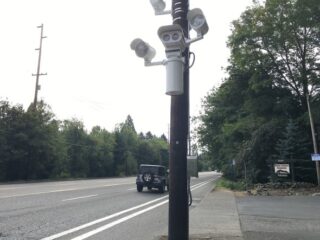One line in a recent Beaverton Police Department press release caught my eye: “Between 07/01/2015 and 07/01/2016 over 94,000 drivers were traveling 11 mph or more, above the speed limit.”
I’m well aware that most people drive faster than they should. But 94,000? That’s a lot of speeders!
Thankfully there’s a silver lining. The release also announced that BPD would start issuing citations to some of those people this coming Tuesday, October 16th (warnings have been mailed since September 15th). The way they’ll manage this sudden influx of enforcement activity is by using photo radar cameras thanks to a law passed in 2017 that allows them to cite speeders using cameras that have until now only nabbed red light runners.
Portland will take advantage of the same law, but it will likely be at least several months before our cameras are ready. Here’s why:
The City of Portland has been in a leader in using automated enforcement. They started operating mobile photo radar vans in 1995 and put up their first red light camera in 1999. Portland received authority to install its first speed cameras in 2015 and as of February of this year they’ve installed eight of them. Two cameras are placed (one facing each direction) on Beaverton-Hillsdale Highway (between Hillsdale Town Center and SW Shattuck Road), SE Division Street (between 148th and 162nd), SE 122nd Avenue (between Foster and Holgate), and NE Marine Drive (eastbound near NE 33rd Drive, westbound near NE 138th Ave). As per the law, Portland can only install speed cameras on high crash corridors.
In the 2017 legislative session, Oregon passed House Bill 2409 which allowed cities to use existing red light cameras to catch speeders as well.
Beaverton’s 94,000 speeders were counted at just four intersections. Portland has red light cameras at 11 intersections. Will we follow Beaverton’s lead and start using them to cite speeders too?
Unfortunately not.
Eager to see more automated enforcement, I asked PBOT Communications Director John Brady if our red light cameras will take advantage of the 2017 law. Brady said it’s in their plans, but it won’t happen in the near term. “This is because the existing red light camera technology that we have is too old and can’t be adapted to also serve the speed safety function,” he shared via an email today. “We’re working on an RFP for a new contract for these cameras.” That new contract would allow PBOT to upgrade the cameras so they can serve both functions. Brady added that the RFP will be released “in the coming months.”
Hopefully the camera upgrades can be made by next year so they’re up-and-running by the time we see major road design changes as part of the Central City in Motion projects. Unlike the existing speed cameras which are all located far outside the urban core, several of our red light cameras (that will eventually cite speeders too) are in the urban core. The locations include: NE Grand Ave. and E. Burnside St.; NE Sandy Blvd. and NE Cesar Chavez Blvd.; NE Cesar Chavez Blvd. and NE Sandy Blvd.; W Burnside St. and 19th Ave.; NE Broadway St. and NE Grand Ave.; SE Foster Rd. and SE 96th Ave.; SE Stark St. and SE 102nd Ave.; SE Stark St. and SE 99th Ave.; SE Washington St. and SE 103rd Ave.; SE Grand Ave. and SE Madison St.; and SW 4th Ave. and SW Jefferson St.
These cameras work and they’re a potent weapon in PBOT’s arsenal in the war on speeding. The first three speed cameras PBOT installed resulted in an 85% decrease in “top-end speeding” (defined as 10 mph or more over the posted limit).
Stay tuned.
— Jonathan Maus: (503) 706-8804, @jonathan_maus on Twitter and jonathan@bikeportland.org
Never miss a story. Sign-up for the daily BP Headlines email.
BikePortland needs your support.
The post Beaverton traffic cameras caught 94,000 people speeding in one year appeared first on BikePortland.org.
from BikePortland.org https://ift.tt/2Cg88Hg



No comments:
Post a Comment